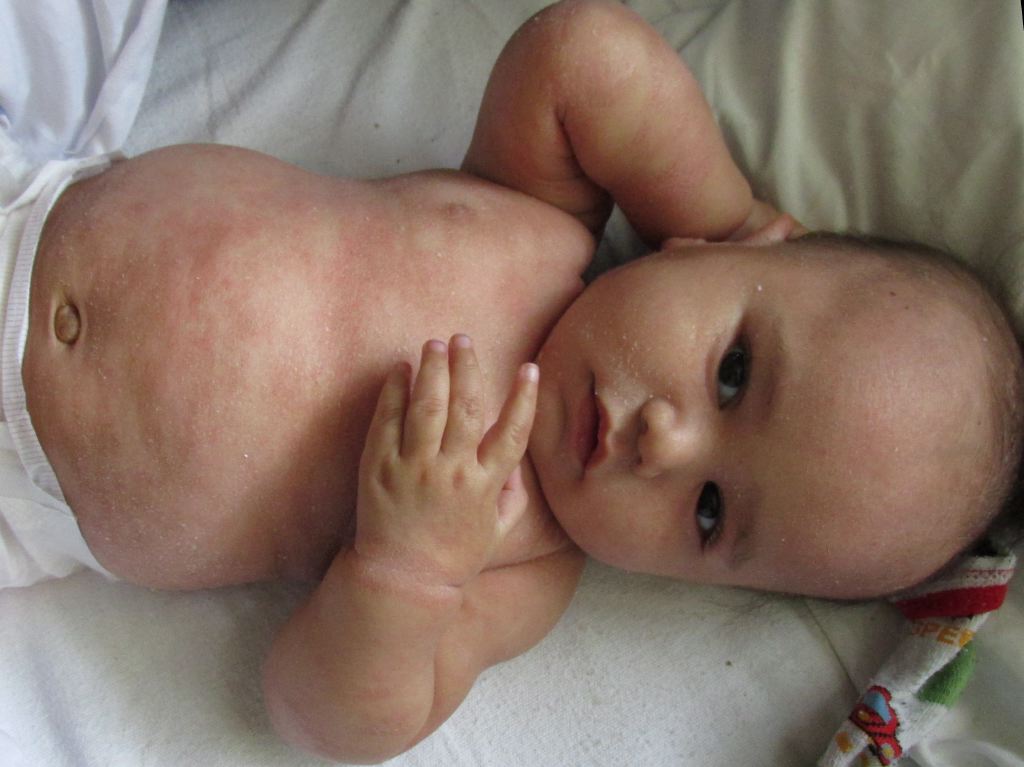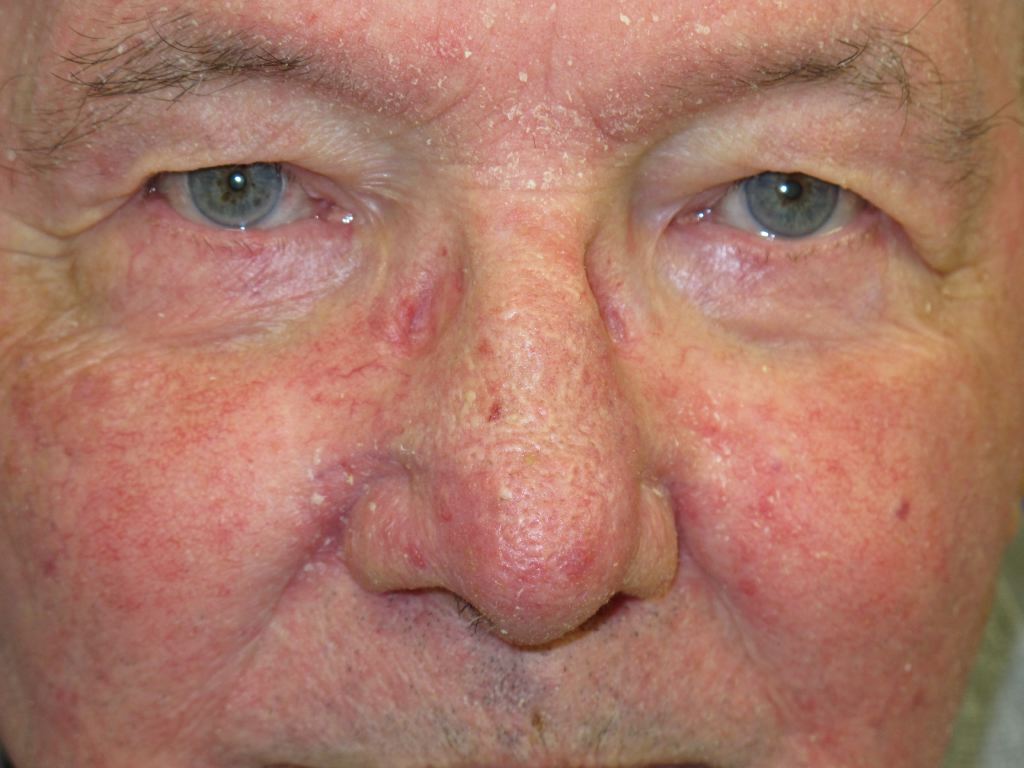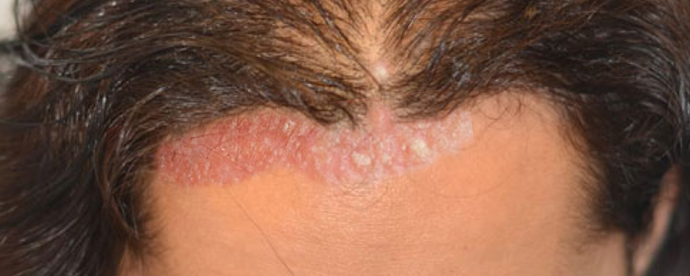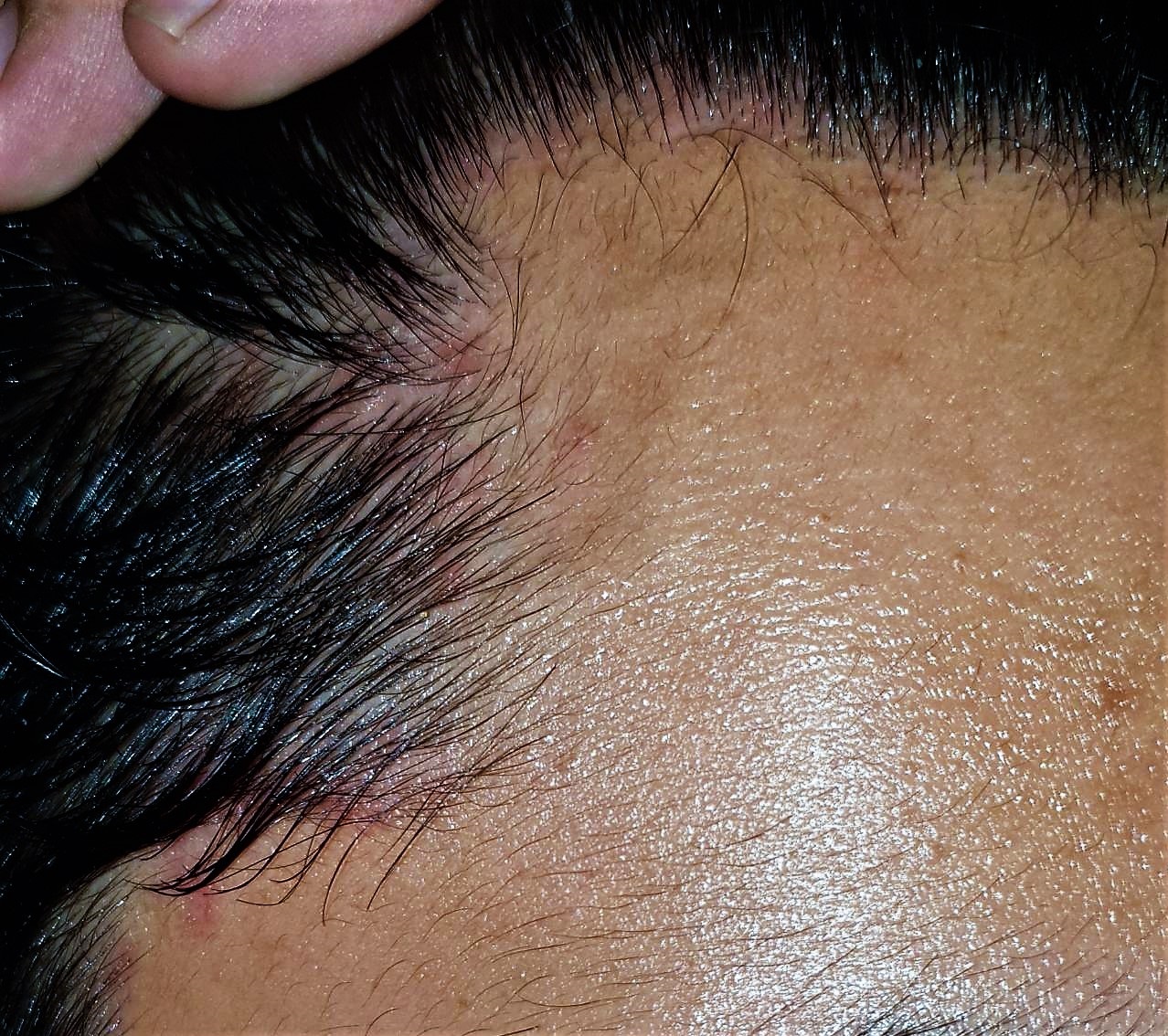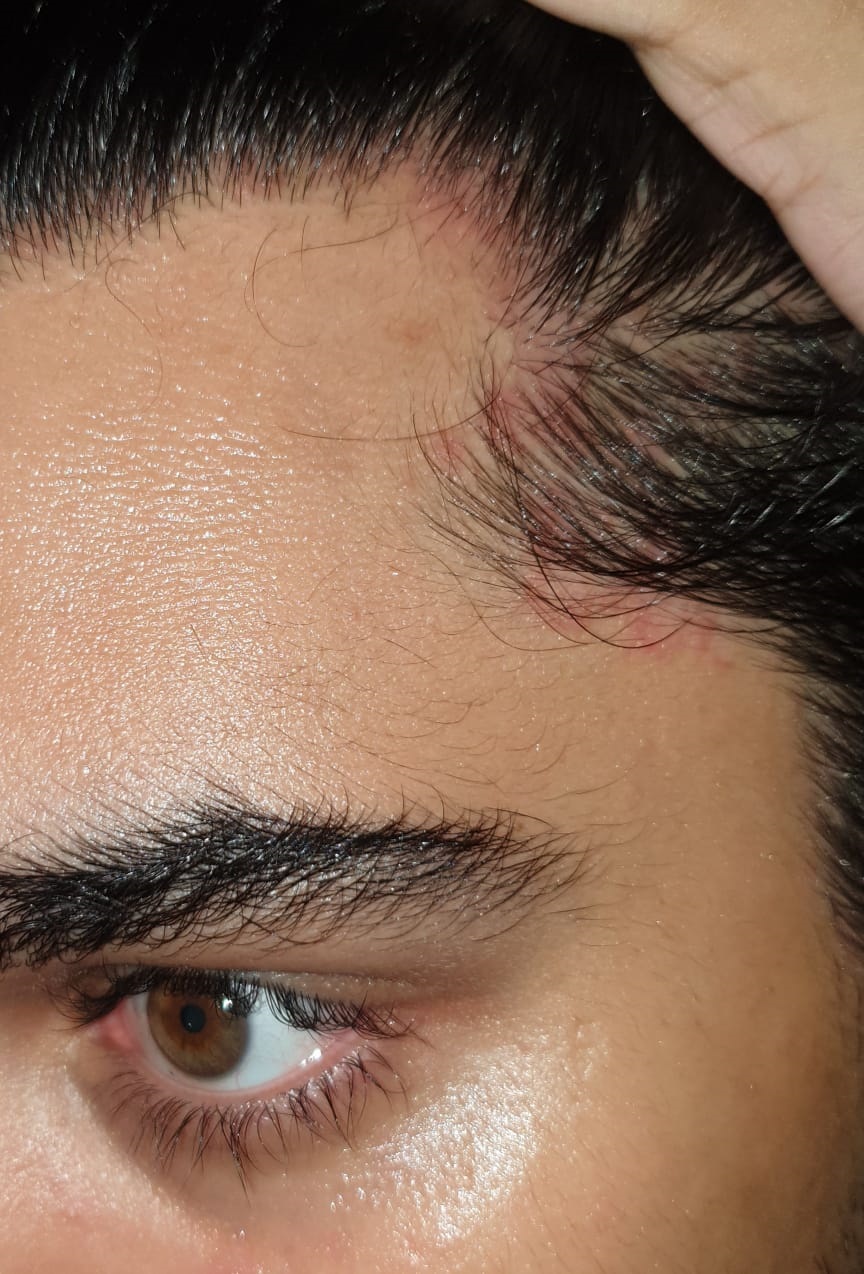[1]
Heath CR, Usatine RP. Seborrheic dermatitis. The Journal of family practice. 2021 Nov:70(9):E3-E4. doi: 10.12788/jfp.0315. Epub
[PubMed PMID: 34818158]
[2]
Sampogna F, Linder D, Piaserico S, Altomare G, Bortune M, Calzavara-Pinton P, Vedove CD, Girolomoni G, Peserico A, Sala R, Abeni D. Quality of life assessment of patients with scalp dermatitis using the Italian version of the Scalpdex. Acta dermato-venereologica. 2014 Jul:94(4):411-4. doi: 10.2340/00015555-1731. Epub
[PubMed PMID: 24287710]
Level 2 (mid-level) evidence
[3]
Wikramanayake TC, Borda LJ, Miteva M, Paus R. Seborrheic dermatitis-Looking beyond Malassezia. Experimental dermatology. 2019 Sep:28(9):991-1001. doi: 10.1111/exd.14006. Epub 2019 Aug 19
[PubMed PMID: 31310695]
[4]
Lin Q, Panchamukhi A, Li P, Shan W, Zhou H, Hou L, Chen W. Malassezia and Staphylococcus dominate scalp microbiome for seborrheic dermatitis. Bioprocess and biosystems engineering. 2021 May:44(5):965-975. doi: 10.1007/s00449-020-02333-5. Epub 2020 Mar 26
[PubMed PMID: 32219537]
[5]
Zani MB, Soares RC, Arruda AC, de Arruda LH, Paulino LC. Ketoconazole does not decrease fungal amount in patients with seborrhoeic dermatitis. The British journal of dermatology. 2016 Aug:175(2):417-21. doi: 10.1111/bjd.14501. Epub 2016 May 29
[PubMed PMID: 26920094]
[6]
Tao R, Li R, Wang R. Skin microbiome alterations in seborrheic dermatitis and dandruff: A systematic review. Experimental dermatology. 2021 Oct:30(10):1546-1553. doi: 10.1111/exd.14450. Epub 2021 Aug 27
[PubMed PMID: 34415635]
Level 1 (high-level) evidence
[7]
Palamaras I, Kyriakis KP, Stavrianeas NG. Seborrheic dermatitis: lifetime detection rates. Journal of the European Academy of Dermatology and Venereology : JEADV. 2012 Apr:26(4):524-6. doi: 10.1111/j.1468-3083.2011.04079.x. Epub 2011 Apr 27
[PubMed PMID: 21521374]
[8]
Sanders MGH, Pardo LM, Franco OH, Ginger RS, Nijsten T. Prevalence and determinants of seborrhoeic dermatitis in a middle-aged and elderly population: the Rotterdam Study. The British journal of dermatology. 2018 Jan:178(1):148-153. doi: 10.1111/bjd.15908. Epub 2017 Dec 8
[PubMed PMID: 28856679]
[9]
Scognamiglio P, Chiaradia G, De Carli G, Giuliani M, Mastroianni CM, Aviani Barbacci S, Buonomini AR, Grisetti S, Sampaolesi A, Corpolongo A, Orchi N, Puro V, Ippolito G, Girardi E, SENDIH Study Group. The potential impact of routine testing of individuals with HIV indicator diseases in order to prevent late HIV diagnosis. BMC infectious diseases. 2013 Oct 10:13():473. doi: 10.1186/1471-2334-13-473. Epub 2013 Oct 10
[PubMed PMID: 24112129]
[10]
Lally A, Casabonne D, Imko-Walczuk B, Newton R, Wojnarowska F. Prevalence of benign cutaneous disease among Oxford renal transplant recipients. Journal of the European Academy of Dermatology and Venereology : JEADV. 2011 Apr:25(4):462-70. doi: 10.1111/j.1468-3083.2010.03814.x. Epub 2010 Aug 25
[PubMed PMID: 20738465]
[11]
Dessinioti C, Katsambas A. Seborrheic dermatitis: etiology, risk factors, and treatments: facts and controversies. Clinics in dermatology. 2013 Jul-Aug:31(4):343-351. doi: 10.1016/j.clindermatol.2013.01.001. Epub
[PubMed PMID: 23806151]
[12]
Niemann N, Billnitzer A, Jankovic J. Parkinson's disease and skin. Parkinsonism & related disorders. 2021 Jan:82():61-76. doi: 10.1016/j.parkreldis.2020.11.017. Epub 2020 Nov 20
[PubMed PMID: 33248395]
[13]
Adalsteinsson JA, Kaushik S, Muzumdar S, Guttman-Yassky E, Ungar J. An update on the microbiology, immunology and genetics of seborrheic dermatitis. Experimental dermatology. 2020 May:29(5):481-489. doi: 10.1111/exd.14091. Epub 2020 Mar 16
[PubMed PMID: 32125725]
[14]
Schwartz JR, Messenger AG, Tosti A, Todd G, Hordinsky M, Hay RJ, Wang X, Zachariae C, Kerr KM, Henry JP, Rust RC, Robinson MK. A comprehensive pathophysiology of dandruff and seborrheic dermatitis - towards a more precise definition of scalp health. Acta dermato-venereologica. 2013 Mar 27:93(2):131-7. doi: 10.2340/00015555-1382. Epub
[PubMed PMID: 22875203]
[15]
Sampaio AL, Mameri AC, Vargas TJ, Ramos-e-Silva M, Nunes AP, Carneiro SC. Seborrheic dermatitis. Anais brasileiros de dermatologia. 2011 Nov-Dec:86(6):1061-71; quiz 1072-4
[PubMed PMID: 22281892]
[16]
Dall'Oglio F, Nasca MR, Gerbino C, Micali G. An Overview of the Diagnosis and Management of Seborrheic Dermatitis. Clinical, cosmetic and investigational dermatology. 2022:15():1537-1548. doi: 10.2147/CCID.S284671. Epub 2022 Aug 6
[PubMed PMID: 35967915]
Level 3 (low-level) evidence
[17]
Gaitanis G, Magiatis P, Hantschke M, Bassukas ID, Velegraki A. The Malassezia genus in skin and systemic diseases. Clinical microbiology reviews. 2012 Jan:25(1):106-41. doi: 10.1128/CMR.00021-11. Epub
[PubMed PMID: 22232373]
[18]
Peyrí J, Lleonart M, Grupo español del Estudio SEBDERM. [Clinical and therapeutic profile and quality of life of patients with seborrheic dermatitis]. Actas dermo-sifiliograficas. 2007 Sep:98(7):476-82
[PubMed PMID: 17669302]
Level 2 (mid-level) evidence
[19]
Hassan S, Szeto MD, Sivesind TE, Memon R, Muneem A, Victoire A, Magin PJ, van Driel ML, Nashawaty M, Dellavalle RP. From the Cochrane Library: Interventions for infantile seborrheic dermatitis (including cradle cap). Journal of the American Academy of Dermatology. 2022 Feb:86(2):e87-e88. doi: 10.1016/j.jaad.2021.09.031. Epub 2021 Sep 24
[PubMed PMID: 34571061]
[21]
Amorim GM, Fernandes NC. Pityriasis amiantacea: a study of seven cases. Anais brasileiros de dermatologia. 2016 Sep-Oct:91(5):694-696. doi: 10.1590/abd1806-4841.20164951. Epub
[PubMed PMID: 27828657]
Level 3 (low-level) evidence
[22]
Ayanlowo OO, Olowoyo OO, Akinkugbe AO, Adelekan FA, Ahamneze NC. Pityriasis amiantacea: a case report. The Nigerian postgraduate medical journal. 2014 Jun:21(2):196-8
[PubMed PMID: 25167599]
Level 3 (low-level) evidence
[23]
Forrestel AK, Kovarik CL, Mosam A, Gupta D, Maurer TA, Micheletti RG. Diffuse HIV-associated seborrheic dermatitis - a case series. International journal of STD & AIDS. 2016 Dec:27(14):1342-1345
[PubMed PMID: 27013615]
Level 2 (mid-level) evidence
[24]
Augustin M, Kirsten N, Körber A, Wilsmann-Theis D, Itschert G, Staubach-Renz P, Maul JT, Zander N. Prevalence, predictors and comorbidity of dry skin in the general population. Journal of the European Academy of Dermatology and Venereology : JEADV. 2019 Jan:33(1):147-150. doi: 10.1111/jdv.15157. Epub 2018 Jul 24
[PubMed PMID: 29953684]
[25]
Hald M, Arendrup MC, Svejgaard EL, Lindskov R, Foged EK, Saunte DM, Danish Society of Dermatology. Evidence-based Danish guidelines for the treatment of Malassezia-related skin diseases. Acta dermato-venereologica. 2015 Jan:95(1):12-9. doi: 10.2340/00015555-1825. Epub
[PubMed PMID: 24556907]
[26]
Victoire A, Magin P, Coughlan J, van Driel ML. Interventions for infantile seborrhoeic dermatitis (including cradle cap). The Cochrane database of systematic reviews. 2019 Mar 4:3(3):CD011380. doi: 10.1002/14651858.CD011380.pub2. Epub 2019 Mar 4
[PubMed PMID: 30828791]
Level 1 (high-level) evidence
[27]
Cheong WK, Yeung CK, Torsekar RG, Suh DH, Ungpakorn R, Widaty S, Azizan NZ, Gabriel MT, Tran HK, Chong WS, Shih IH, Dall'Oglio F, Micali G. Treatment of Seborrhoeic Dermatitis in Asia: A Consensus Guide. Skin appendage disorders. 2016 May:1(4):187-96. doi: 10.1159/000444682. Epub 2016 Mar 23
[PubMed PMID: 27386464]
Level 3 (low-level) evidence
[28]
Das A, Panda S. Use of Topical Corticosteroids in Dermatology: An Evidence-based Approach. Indian journal of dermatology. 2017 May-Jun:62(3):237-250. doi: 10.4103/ijd.IJD_169_17. Epub
[PubMed PMID: 28584365]
[29]
Kamamoto CSL, Nishikaku AS, Gompertz OF, Melo AS, Hassun KM, Bagatin E. Cutaneous fungal microbiome: Malassezia yeasts in seborrheic dermatitis scalp in a randomized, comparative and therapeutic trial. Dermato-endocrinology. 2017:9(1):e1361573. doi: 10.1080/19381980.2017.1361573. Epub 2017 Oct 23
[PubMed PMID: 29484095]
Level 2 (mid-level) evidence
[30]
Abbas Z, Ghodsi SZ, Abedeni R. Effect of itraconazole on the quality of life in patients with moderate to severe seborrheic dermatitis: a randomized, placebo-controlled trial. Dermatology practical & conceptual. 2016 Jul:6(3):11-6. doi: 10.5826/dpc.0603a04. Epub 2016 Jul 31
[PubMed PMID: 27648378]
Level 2 (mid-level) evidence
[31]
Skorvanek M, Bhatia KP. The Skin and Parkinson's Disease: Review of Clinical, Diagnostic, and Therapeutic Issues. Movement disorders clinical practice. 2017 Jan-Feb:4(1):21-31. doi: 10.1002/mdc3.12425. Epub 2016 Sep 8
[PubMed PMID: 30363435]
[32]
Piquero-Casals J, La Rotta-Higuera E, Francisco Mir-Bonafé J, Rozas-Muñoz E, Granger C. Non-Steroidal Topical Therapy for Facial Seborrheic Dermatitis. Journal of drugs in dermatology : JDD. 2020 Jun 1:19(6):658-660. doi: 10.36849/JDD.2020.10.36849/JDD.2020.5121. Epub
[PubMed PMID: 32574015]
[33]
Gupta AK, Versteeg SG. Topical Treatment of Facial Seborrheic Dermatitis: A Systematic Review. American journal of clinical dermatology. 2017 Apr:18(2):193-213. doi: 10.1007/s40257-016-0232-2. Epub
[PubMed PMID: 27804089]
Level 1 (high-level) evidence
[34]
Araya M, Kulthanan K, Jiamton S. Clinical Characteristics and Quality of Life of Seborrheic Dermatitis Patients in a Tropical Country. Indian journal of dermatology. 2015 Sep-Oct:60(5):519. doi: 10.4103/0019-5154.164410. Epub
[PubMed PMID: 26538714]
Level 2 (mid-level) evidence
[35]
Schwartz JL, Clinton TS. Darier's disease misdiagnosed as severe seborrheic dermatitis. Military medicine. 2011 Dec:176(12):1457-9
[PubMed PMID: 22338367]
[36]
Pärna E, Aluoja A, Kingo K. Quality of life and emotional state in chronic skin disease. Acta dermato-venereologica. 2015 Mar:95(3):312-6. doi: 10.2340/00015555-1920. Epub
[PubMed PMID: 24978135]
Level 2 (mid-level) evidence
[37]
Sanders MGH, Pardo LM, Ginger RS, Kiefte-de Jong JC, Nijsten T. Association between Diet and Seborrheic Dermatitis: A Cross-Sectional Study. The Journal of investigative dermatology. 2019 Jan:139(1):108-114. doi: 10.1016/j.jid.2018.07.027. Epub 2018 Aug 18
[PubMed PMID: 30130619]
Level 2 (mid-level) evidence

